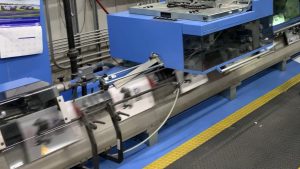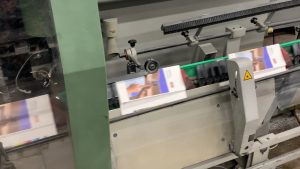

There’s so much more to binding than just paperback or hardcover. From the look to the weight to the longevity of the finished publication, it’s important to know how each binding technique can suit the unique needs of your publication and differentiate you from the competition.
In this series, we explore how different binding processes are performed in a commercial setting and how they affect the final product.
What is saddle-stitch binding?
Saddle stitching, also called the two-wire stitch or stapled spine, is a popular, cost-effective binding method widely used for thinner magazines, catalogs and booklets. In this binding process, sheets of printed paper are folded and nested together, then metal wire is stitched through the fold line to create the spine. After trimming, the end product is a sleek, softcover publication bound with staples through its spine.Ã˝
Assembly requiredÃ˝
In commercial printing, saddle stitching varies between machinery and binderies, but the basic process in a saddle stitching line is as follows.Ã˝
Once a publication‚Äôs parent sheets leave the printing press, a gatherer organizes the sheets into the correct sequence. The parent sheets are sent into gates in a folder machine which are set to the proper fold size for the sheets. The cover of the publication is usually combined with the parent sheets, so long as the substance of the cover is able to be folded alongside its pages.Ã˝Ã˝
 The folding process ensures crisp, precise folds along the spine. A heavy arm applies a final fold, called the knife fold, to the parent sheets along the fold line with great pressure.Ã˝Ã˝
The folding process ensures crisp, precise folds along the spine. A heavy arm applies a final fold, called the knife fold, to the parent sheets along the fold line with great pressure.Ã˝Ã˝
The groups of folded pages, known as signatures, are intentionally printed and folded to be longer on one edge than the other. This creates a small lap which aids the machine in opening the unbound publication to the centerfold, assuring each publication is correctly pulled onto the stitcher‚Äôs conveyor.Ã˝
The publication travels along the apparatus with its outer spine facing up and each side of the publication hanging over the sides like legs on a saddle. This part of the binding process is where saddle stitching gets its distinctive name.
As the publication travels along the conveyor, it meets the stitcher, which pushes metal wire from a spool down through the outside of the spine fold and back up through the other side. This process forms staples in the spine fold of the publication which are clinched on the inside fold of the centermost pages. Two staples are used most commonly, but publications with larger paper sizes may require more staples along the spine.
The stapled publication is then plucked off the saddle conveyor and sent to the trimmer. Usually on-line, the trimmer contains three blades which trim the three unbound edges of the publication, also known as the head, foot and thumb edges. This process removes the lap and signature folds of the cover and inside pages at once, leaving behind a clean-cut, saddle-stitched publication. 
Use cases for saddle-stitched productsÃ˝
Saddle stitching is a very popular binding method due to its simplicity, cost-effectiveness, fast turnaround and flexible design.Ã˝Ã˝
This binding method is highly cost effective, both in production and shipping costs. If a large quantity of publications needs to be shipped over a long distance, saddle stitching is beneficial to shipping costs as this binding method adds only a minimal amount of excess bulk and weight.Ã˝
 After being sent to press, saddle-stitched products have a fast turnaround relative to other binding techniques like case or perfect binding. Saddle stitching produces a durable product with pages that do not slip or fall out. Any softcover publication is less durable than a hardcover publication, but the longevity of saddle-stitched products can be extended with a thicker cover substance or cover coating.Ã˝Ã˝
After being sent to press, saddle-stitched products have a fast turnaround relative to other binding techniques like case or perfect binding. Saddle stitching produces a durable product with pages that do not slip or fall out. Any softcover publication is less durable than a hardcover publication, but the longevity of saddle-stitched products can be extended with a thicker cover substance or cover coating.Ã˝Ã˝
One of the biggest design benefits of saddle stitched publications is their ability to lay flat when opened. Since the pages open flat, images and text can extend across a double page spread, with the content in full view and without any content getting‚ÄØlost in the gutter. The ability to print without design-specific restrictions is beneficial for printing publications with large photo spreads, as well as items like maps and testing booklets. 
When considering saddle stitching for a printing project, the main determining factor is the page count of the future publication. This binding method is most commonly used for print materials with a small number of pages. Saddle stitching is best suited for printed page counts of 16 to 64, but products can have page counts as low as eight and as high as 80, depending on the chosen weight of the paper.Ã˝Ã˝
The page count for this binding type must be in multiples of four ‚Äì including the front and back cover ‚Äì as each sheet creates four pages when it is printed on front and back and folded in half. For example, printing an 8.5‚Äù x 11‚Äù saddle-stitch catalog, the pages and cover would be printed on 17‚Äù x 11‚Äù sheets which are folded in half to the size of 8.5‚Äù x 11‚Äù.Ã˝
If the planned publication is to be more than 0.25 inches thick, it may be advantageous to look into other methods such as stab stitching or perfect binding, which can accommodate thicker publications. Keep in mind, these binding methods sacrifice the ability of publications to lay flat and gutter space will need to be considered in the design phase.Ã˝Ã˝
A drawback to the design of saddle-stitched publications is the inability to print on the spine, which can limit the lifespan of a publication on the shelf. This design drawback is not much of a problem for many short, single-run booklets, but it can be a disadvantage if it reduces the visibility of a magazine on a stand.Ã˝
In saddle-stitched publications with a large number of pages, it is possible for the pages to bow out from the spine and the stitches are more likely to spring out over time.Ã˝Ã˝
Creeping also needs to be taken into account during the design of a saddle-stitched product with a larger number of pages. Creeping refers to the gradual edge protrusion of the inner pages of a publication as more pages are nested together. After assembly, the unbound edges are trimmed to create a flush edge, but it is important to allot for creep allowance to avoid errors such as page numbers getting cut off of the centermost pages. With more pages in a publication, more creep allowance is necessary.Ã˝Ã˝
Weighing the optionsÃ˝
Saddle stitching allows for a cost-effective publication with a faster production speed versus other binding methods, while still producing a professional-looking end product. For printed works intended to have short-term use, or those with a smaller page count, saddle stitch binding is an excellent option. Saddle stitching is often used for workbooks, wall calendars, comic books and thinner magazines and catalogs.Ã˝
If you are considering saddle stitch binding for your next print project with –”∞…‘≠¥¥ or you would like to speak with someone to discuss what would work best for your publication, our knowledgeable staff can help find the best option for you!Ã˝
